Pickleball court is the heart of the game, providing a designated space for players to enjoy a fun, engaging, and competitive sport. Designed to be versatile, they accommodate both casual and competitive play and can be found in various settings, from parks and community centers to private clubs and backyards. Understanding the key features and characteristics of a pickleball court can enhance your gameplay and enjoyment, whether you’re a seasoned player or a curious newcomer.
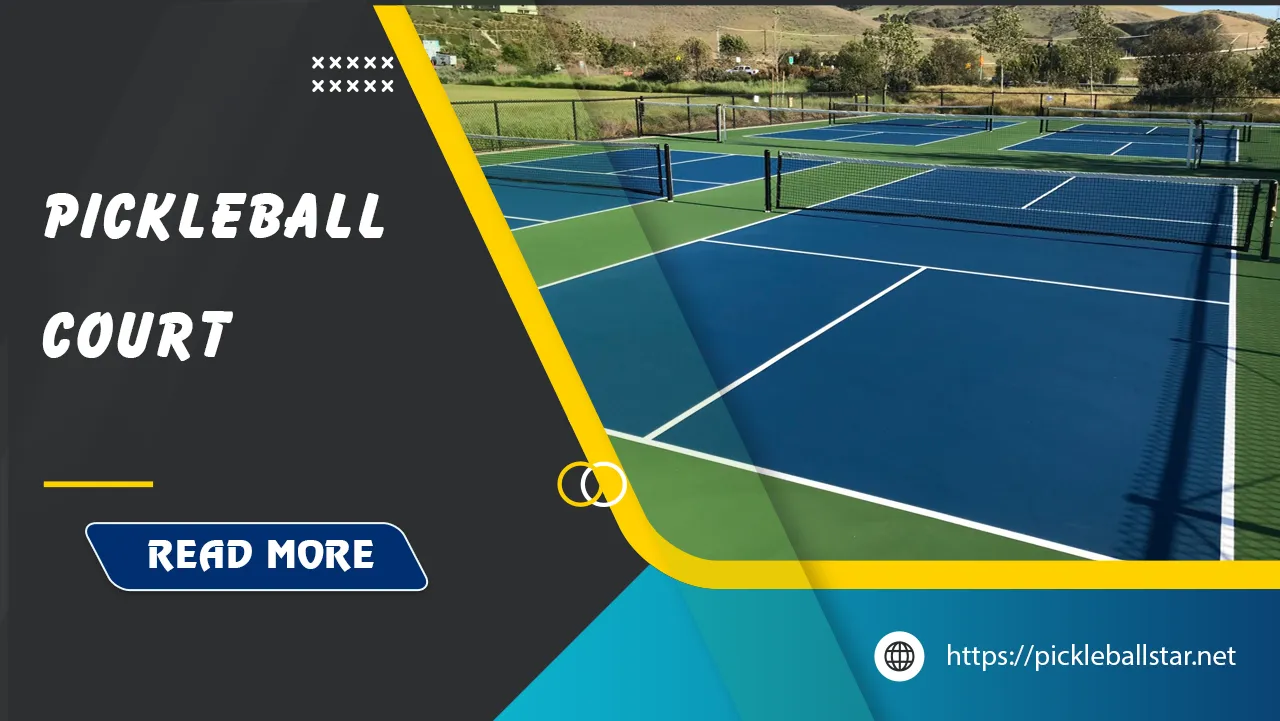
Pickleball Court Dimensions
Standard Court Dimensions
The standard dimensions of a pickleball court are 20 feet wide by 44 feet long. This size remains consistent whether the game is played in singles or doubles format, making the sport accessible and straightforward for new players to learn.
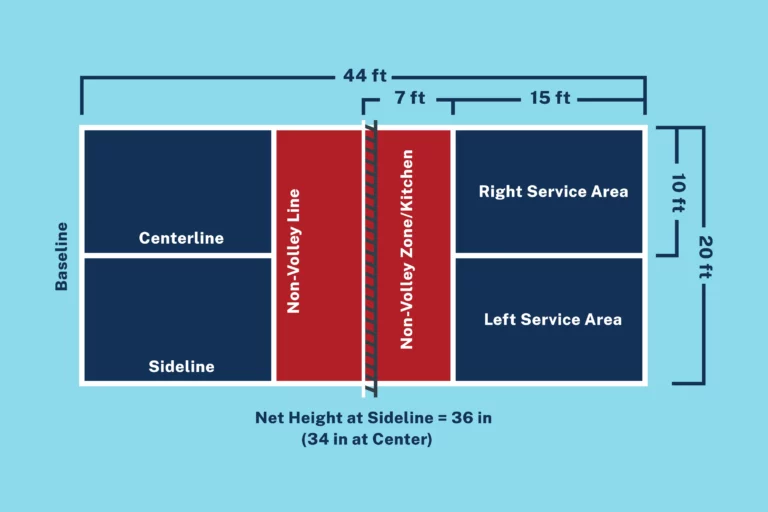
In comparison to tennis courts, which are 36 feet wide and 78 feet long, pickleball courts are much smaller. This reduction in size contributes to the faster-paced nature of the game, as players have less ground to cover and can engage in quick volleys and strategic plays. The reduced court size ensures that pickleball is a sport enjoyed equally by players of all ages and skill levels.
Singles Court Dimensions
While the standard dimensions of the pickleball court remain at 20 feet by 44 feet, singles play introduces specific strategies that take advantage of the restricted space. The court does not change in size between singles and doubles play, ensuring that players familiarize themselves with a single court layout, enhancing consistency and predictability in gameplay.
By maintaining a smaller court size, the game becomes more about precision, agility, and tactical wit. Unlike big, sweeping shots that dominate tennis, pickleball emphasizes quick reflexes and smart placement of shots, keeping the rally dynamic and engaging for players.
Doubles Court Dimensions
Similar to singles, the doubles court dimensions in pickleball stay the same at 20 feet wide by 44 feet long. This consistency means that players can switch between singles and doubles games without needing adjustment to different court dimensions.
In doubles, the compact court size fosters teamwork and communication, as players must coordinate their movements closely to cover the court efficiently. The smaller dimensions necessitate a higher degree of synchronization and strategic placement of shots to outmaneuver the opposing pair, making for thrilling and competitive matches.
Pickleball Court Markings and Zones
Service Areas

The service areas on a pickleball court are critical for setting the stage for each rally. Each side of the court is divided into two equal service boxes, 10 feet wide, separated by a centerline. This setup encourages precision in plays and requires the server to target specific areas, setting the tempo for the rally.
Proper service techniques involve placing the ball within these designated areas and leveraging the placement to gain an advantage over the opponent. Mastering serves in these specific zones can become a key tactic, influencing the flow and control of the game.
Non-Volley Zone (The Kitchen)
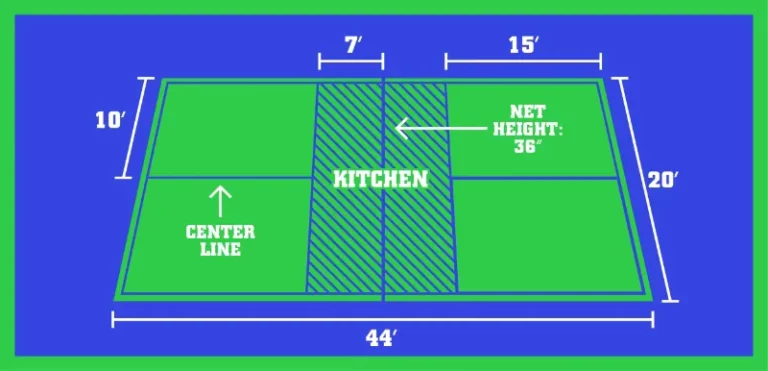
The non-volley zone, affectionately known as the “kitchen,” extends 7 feet from the net on both sides of the court. This area plays a pivotal role in ensuring the game focuses on skill rather than sheer power by prohibiting volleys within this space.
Players are not allowed to strike the ball in the air when standing within the kitchen. This restriction encourages longer rallies and creative play strategies such as drop shots, which can bait opponents into the kitchen, where they’re unable to return powerful volleys, thereby encouraging deft, strategic placement over brute force.
Baselines
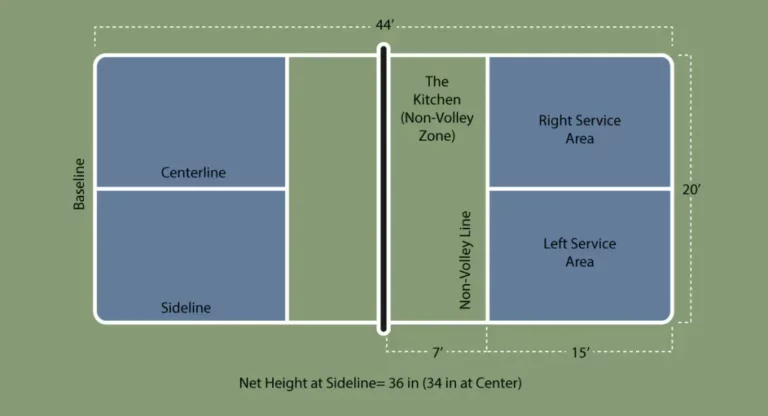
The baselines are the end boundaries of the court, located at the farthest edges from the net. These lines are crucial for dictating gameplay boundaries during serves and strokes, ensuring that plays remain in-bounds for fair and equitable competition.
Understanding and respecting the baselines’ position is key for accurate servings and strategic returns, providing players with a firm grasp of in-play areas.
Centerline
The centerline divides the service boxes within each court half, marking left and right service areas. It is critical for correct service positioning and fault rulings, offering a guide to players on where to aim their serves and how to position themselves for returns.
The centerline’s role helps in demarcating service areas clearly, preventing disputes and ensuring a common understanding of serving rules. It adds to the precision and systematic structure of the game, making it easier for players to follow official guidelines.
Read more: How to line a Pickleball Court?
Setting Up Your Pickleball Court
Choosing a Location
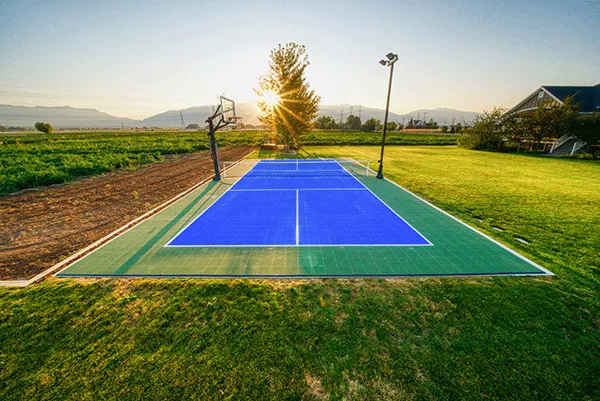
When selecting a location for your pickleball court, consider factors such as available space, surface type, accessibility, and local regulations. The site should be spacious enough to accommodate a standardized 20×44-foot court with ample room for player movement around it.
Surface type can vary, from concrete to asphalt, but it’s vital to opt for a smooth, even surface to avoid injury and ensure consistent ball bounce. Additionally, the location should be easily accessible for all players, minimizing barriers to entry and encouraging maximum participation.
Gathering Materials
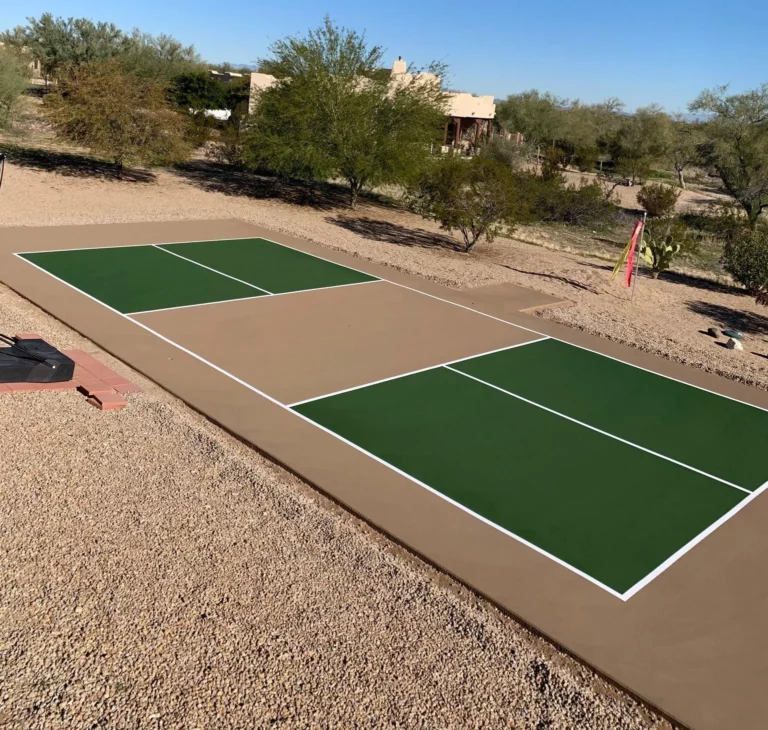
Gathering the right materials is essential for setting up a pickleball court. For temporary markings, you’ll need 200 feet of green tape, two tape measures (25-foot and 50-foot), and chalk or a marker. Permanent markings require similar initial tools, along with paint and paint application supplies.
Using green Frog tape is recommended as it provides strong adhesion while being easy to remove, preserving the court’s surface. Avoid materials like duct tape, which can damage surfaces.
Marking the Lines
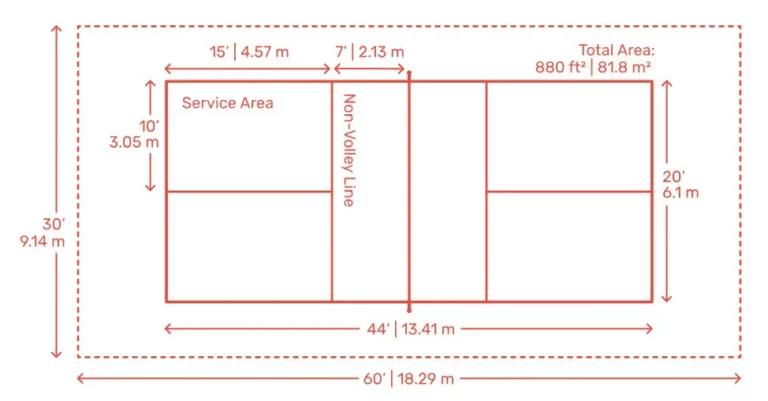
Marking the lines accurately sets the foundation for a professional-standard pickleball court. Begin by measuring a 44-foot line from point A to B. Next, use tape measures to mark 20-foot and 48.33-foot lines to create point C. Continue by marking a 44-foot line from point C to D and a 20-foot line from B to D.
Inner lines are created by marking 15-foot, 22-foot, and 29-foot lines from A to B and C to D, with the 22-foot line serving as the net line. Connect the 10-foot points on the AC and BD lines to create the centerline, completing the layout.
Setting Up the Net
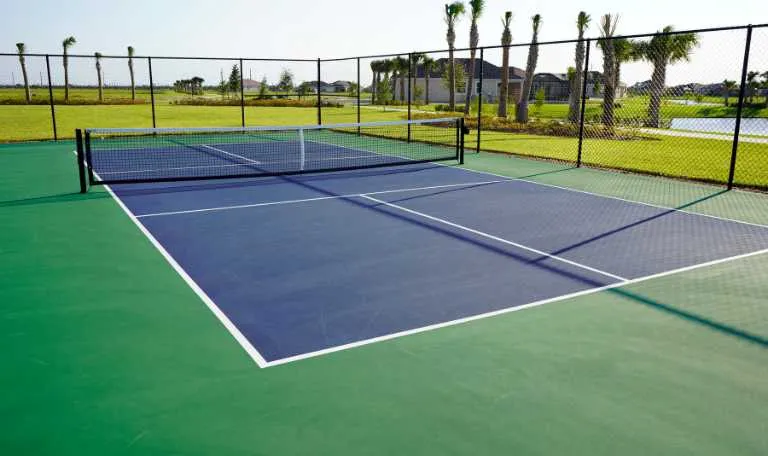
The net should stand 36 inches high at the sidelines and 34 inches high at the center. Securely attach the net to the posts, ensuring proper tension and height. This standard height specification is crucial for maintaining fair gameplay and aligning with official tournament standards.
The net setup must be done meticulously to sustain the true spirit of pickleball, ensuring a taut, even distribution for consistent play dynamics.
Maintaining Your Pickleball Court
Regular Inspection
Regular inspection of your pickleball court is critical in identifying and addressing any wear, cracks, or damage. A planned inspection routine can prevent minor issues from escalating into significant repairs, maintaining a safe and high-quality playing experience.
Regular inspections should check for surface cleanliness, line visibility, net integrity, and any weather-related damage. Documenting these inspections helps in planning maintenance activities effectively.
Repainting the Lines
Repainting the lines on your pickleball court ensures they remain visible and within official dimensions. Generally, lines may need repainting every 3 to 5 years, subject to the level of use and environmental conditions.
Use a high-quality paintbrush or roller for even distribution of paint within the taped lines. Multiple coats with adequate drying time between applications secure a durable finish, preventing smudging and ensuring consistent line appearance.
Using the Right Tools
Utilize appropriate tools for maintaining the court effectively. Tools include a broom with stiff bristles, leaf blower, pressure washer, crack repair kit, paint roller and tray, and court line tape. These tools aid in routine cleaning, crack repairs, and line repainting.
Investing in the right tools ensures that maintenance activities are conducted efficiently, resulting in a well-preserved court that offers optimal play conditions.
Preventing Weather Damage
Concrete and other court surfaces are susceptible to weather-related damage. Applying a protective sealant can help shield the paint from UV rays, moisture, and wear. Regular cleaning, including sweeping and washing with mild soap, prevents debris buildup and mold growth.
Such preventative measures against weather damage enhance the lifespan and durability of the court. Regular maintenance actions such as these contribute to preserving the court’s integrity and playability over the long term.
Types of Pickleball Court Surfaces
- Concrete: Concrete is a popular choice due to its durability and low maintenance. It offers a hard, predictable playing surface ideal for both indoor and outdoor play. However, the rigidity can be tough on the body, necessitating careful consideration of player needs and additional surface treatments to enhance comfort.
- Asphalt: Asphalt courts provide a smooth, resilient surface ideal for outdoor play. Known for their skid resistance, they offer safe gameplay even in wet conditions. While construction is straightforward and doesn’t require curing, the surface lacks shock absorption, potentially causing increased joint discomfort over time.
- Hard Court: Hard courts (Concrete) are highly durable and affordable, requiring minimal maintenance. Though stiff and rigid, often resulting in increased joint strain, they provide consistent ball bounce, making gameplay predictable. Challenges include susceptibility to skidding and risks of falling, especially when wet.
- Grass: Grass courts, typically found in backyard settings, cater to casual play. They demand high maintenance, including regular mowing and watering. The variability in ball bounce and lack of traction present unique gameplay challenges, restricting their use largely to informal, leisurely activities rather than competitive matches.
- Sand: Although less common as traditional surfaces, sand courts could potentially offer a unique, softer play experience. However, the detailed standardization and preparation for sand surfaces as official playing grounds are limited, requiring specific design adaptations for effective use.
Pickleball Court Accessories
Portable Nets
Portable nets are versatile and allow courts to be set up anywhere. Features include tensioned rope structures, lightweight designs, and easy transportation. Prices can range from $128 for basic models to $3,099 for high-end versions. Notable manufacturers include C&D, Douglas, Dominator, and Gamma.
Court Lighting
Proper lighting ensures pickleball can be played in both daylight and evening conditions. Pole-mounted LED fixtures tailored for pickleball courts are adjustable and weatherproof, offering energy-efficient operation and enhancing visibility for nighttime play.
Wind Screens
Wind screens offer resilience against wind interference and provide privacy. Made from durable materials like vinyl-coated polyester, they ensure wind and visual distractions are minimized. Custom sizes and logo printing options are available, enhancing the court’s aesthetics and functionality.
Shade Structures
Shade structures like canopies and permanent pavilions protect players from the sun and adverse weather. Constructed from heavy-duty fabrics and powder-coated steel frames, they cater to player comfort and can be customized to match the court’s layout.
Boundary Markers
Boundary markers ensure clear court demarcation for safe play. Proper marking and visible lines prevent accidents and enhance court etiquette, promoting a well-organized and smooth gameplay experience.
Pickleball Court Safety
Proper Footwear
Wearing court-specific shoes is crucial for both safety and performance. Court shoes offer the necessary support, cushioning, and traction for rapid movements without risking injuries. Regular sneakers or running shoes lack these features, making them unsuitable for pickleball.
Warm-Up and Stretching
A proper warm-up involves activities like brisk walking or light jogging for at least five minutes. Follow this with dynamic stretches targeting major muscle groups to enhance flexibility and reduce the risk of strains, ensuring your body is prepared for play.
Staying Hydrated
Hydration is key to maintaining peak performance and preventing heat-related illnesses. Drink water or electrolyte-replenishing beverages before, during, and after playing. Regular water breaks help ensure you remain hydrated, avoiding symptoms like dizziness or fatigue.
Avoiding Overexertion
To prevent injuries from overexertion, moderate your play intensity, take breaks, and listen to your body’s signals. Building up stamina gradually helps mitigate the risk of overstrain and ensures sustained, enjoyable gameplay.
Following Court Etiquette
Good court etiquette includes calling out scores, avoiding court disruptions, yielding during active shots, and keeping the court clean. Respect for fellow players and the game’s rules ensures a pleasant experience for everyone.
FAQs
What Are the Official Pickleball Court Dimensions?
The official dimensions are 20 feet wide by 44 feet long according to the USA Pickleball Association (USAPA). The total recommended playing area, including extensions, is 30 by 60 feet, with a net height of 36 inches at the sides and 34 inches at the center.
What Are the Different Types of Pickleball Court Surfaces?
Common surfaces include asphalt, concrete, grass, and hard courts. Each offers distinct advantages and considerations, from durability and maintenance requirements to their impact on gameplay and player comfort.
What Are Some Essential Pickleball Court Accessories?
Key accessories include portable nets, court lighting, wind screens, shade structures, and boundary markers. These elements enhance the playing experience by providing functionality, safety, and comfort.
How Do I Maintain My Pickleball Court?
Maintenance involves regular inspection, cleaning, repainting lines, and using the right tools. Preventive measures against weather damage and prompt repairs are crucial to sustaining court quality and safety.
What Are Some Safety Tips for Playing Pickleball?
Key safety tips include wearing proper footwear, warming up and stretching, staying hydrated, avoiding overexertion, and following court etiquette. Attention to these aspects ensures a safe, enjoyable, and injury-free playing experience.
Conclusion
Pickleball courts are the perfect setting for a sport that balances fun and competition. Understanding the unique features and considerations of pickleball court design and construction helps you choose the right surface and optimize your gameplay. Whether playing at a public court, a private club, or building your own court at home, selecting appropriate materials and accessories enhances your pickleball experience, fostering a space where you can enjoy the game to its fullest.
Engage with your community, get on the court, and embrace the joy of pickleball. With the right court setup and safety measures, you’re poised for countless hours of spirited play and friendly competition. Get started today and make sure your court meets your needs, enhances your performance, and provides an unparalleled experience for all pickleball enthusiasts.
Similar Articles:
- Pickleball court dimensions
- Pickleball court vs. Badminton court
- Pickleball court vs tennis court
- How many pickleball courts fit on a tennis court
- Can you play pickleball on a tennis court
- Can you play pickleball in the rain
- Can you play pickleball on grass
- Backyard pickleball Court
- How to Line a Pickleball Court
- Pickleball court cost
- Pickleball court lighting
- Pickleball court maintenance
